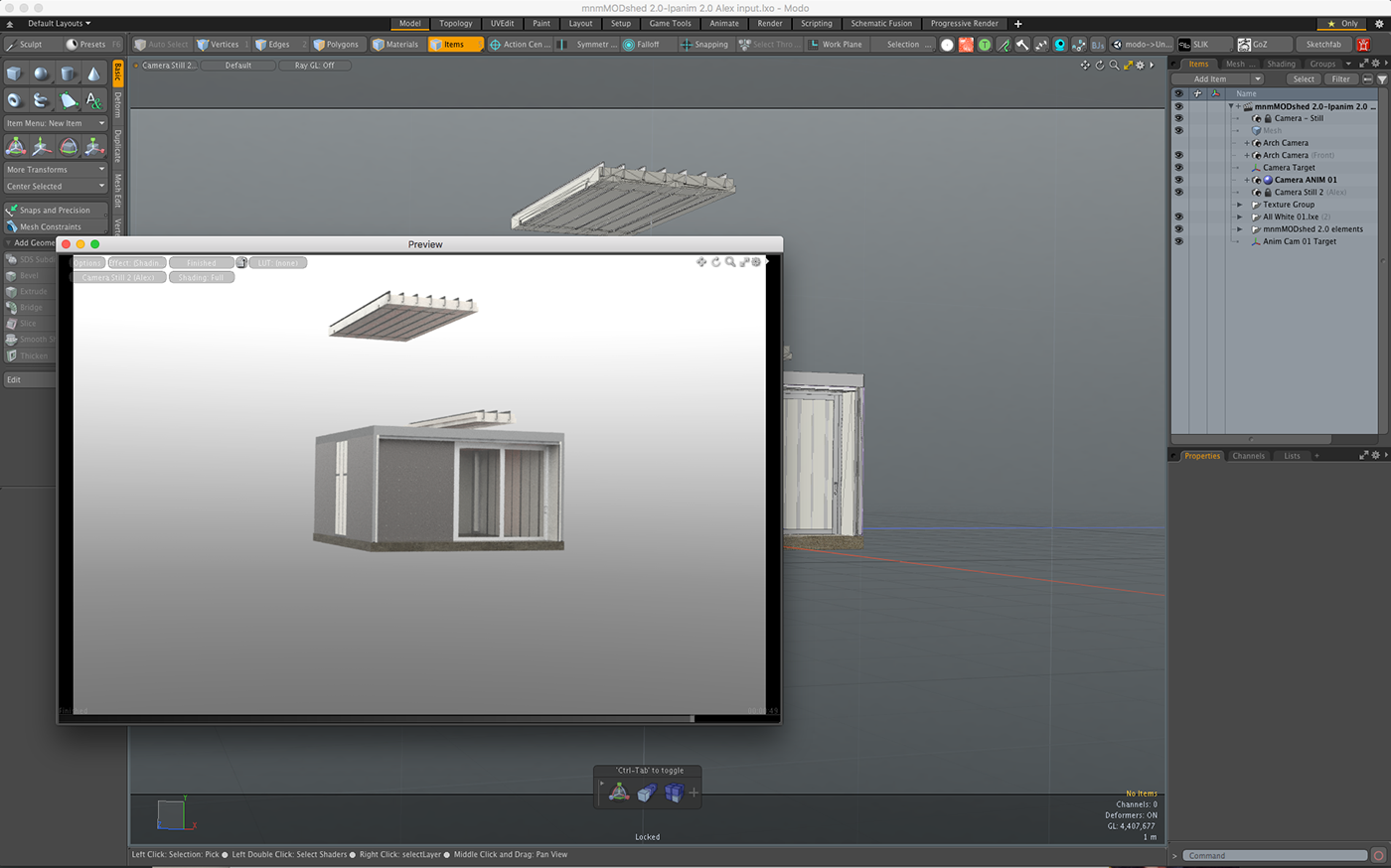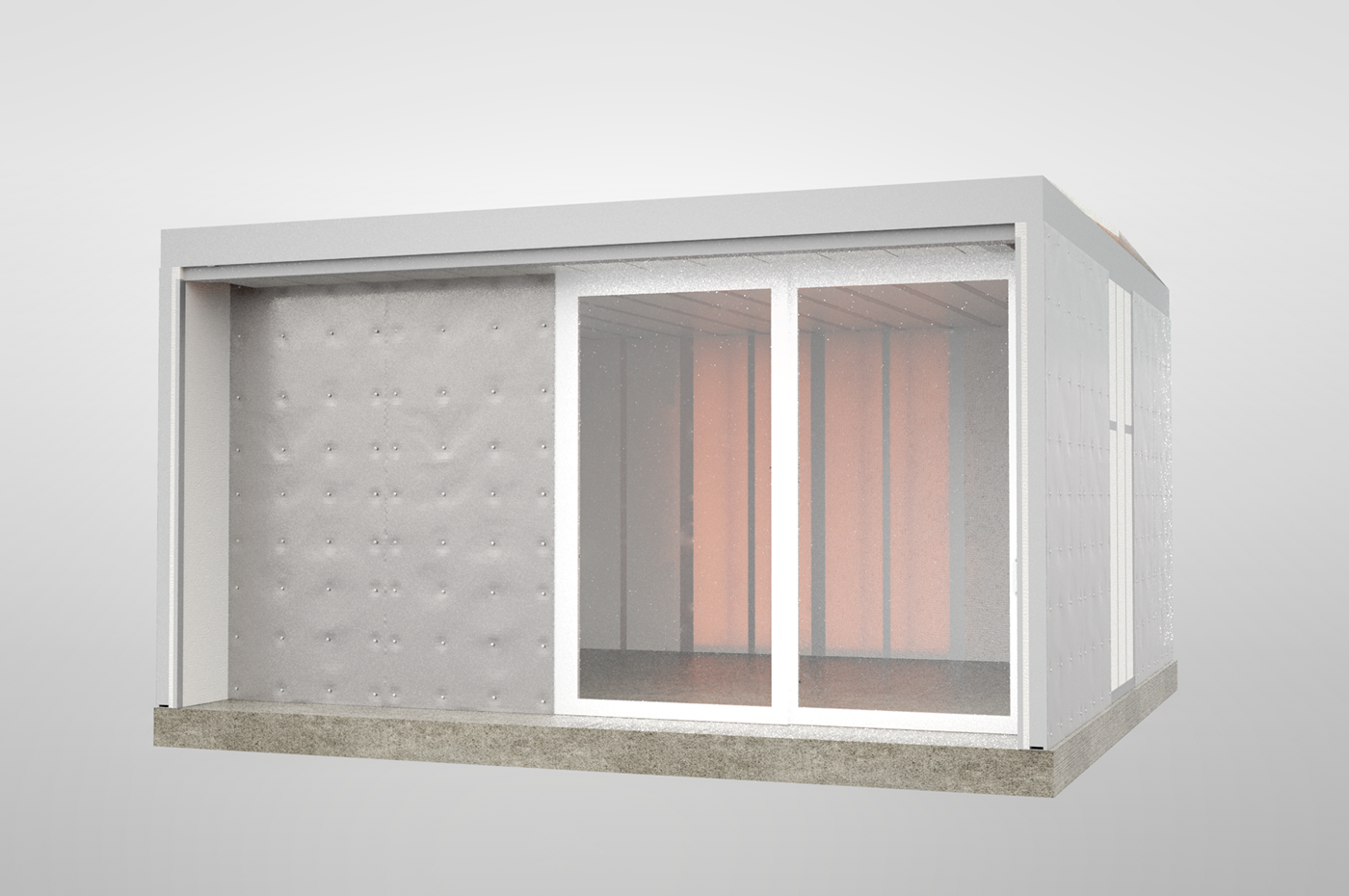Here you can see some of the Foundry | Luxology modo based modeling, texturing, lightings, rigging and animation work I've done lately for a small building systems group called mnmMOD: all core system design depicted herein is property of mnmMOD (even given that some of that design has been executed by me for mnmMOD), though all modeling, texturing, lightings, rigging and animation work is mine alone.

This is one step in an 11-step build-order diagram I designed, modeled & draughted, which is a sub-element of a systems manual I developed in parallel with the new ArchiCAD-based modeling/draughting system I developed for the mnmMOD Building System. I chose this figure as an exemplar because although it shows the level of documentation and method well, there's nothing highly proprietary in this particular view.
This is a quick video showing the assembly of an mnmMOD ceiling panel - simple animation, some render booleans, texturing, lighting and rendertime, plus compositing in Natron. Again, this shows nothing of a highly technical or sensitive nature, and is therefore appropriate to demonstrate my technical capacity.
This does not depict a proper build sequence: rather a vertical stacking to demonstrate groups of elements; this was the proof-of-concept to demonstrate that this method of documentation was something well within my technical scope. As such, this shows nothing of a highly technical or sensitive nature relative to the mnmMOD system, and is therefore appropriate to use here to showcase my technical capabilities.
This video depicts a correct build sequence, from base tracks up to final roof cricket panels, but minus significant technical or sensitive proprietary details, and so is also appropriate to share in this context to demonstrate my capabilities.

A quick in-process screengrab showing the animated camera path and the graph editor showing relative timing curves between keys; the original rough had been with a circular camera path, but the mnmMOD Principal wanted a much less rigid path, with some slight to-and-fro, and a sense of pulling back to see the whole space - hence this far more organic camera path.

Another quick screengrab of a wireframe view of the whole space, mid-animation (see the ceiling panel above enroute downwards to mate with the wall panels), with a camera target (yellow disc locator) acting as an aim constraint during the camera animation - the purple outlined elements are instances (sort of like proxies or blocks) of meshes elsewhere in the file, which decrease the memory required to run a scene with so many geometries being animated.

Screengrab in-process of animating the various elements, with the dopesheet, graph editor and item lists all visible. The dope sheet and graph editor allow for fine control and group editing of various keys, both per item and per channel / per item, and add much of the finesse to the animation workflow.

Another in-process screengrab, this time showing a realtime preview render of this frame from a still camera.

Mid-quality render of finished space; note the sub-surface scatter of light through the EPS foam panels.

Same camera, preview render, space now covered in moisture barrier / building paper; note that I comped a generic name for that paper which is similar to but not confusable with an industry-standard product, to avoid any IP issues.

New camera angle final render, after much design-by-committee discussion.

Same camera angle, now using a tilt-shift camera rig to achieve an "architectural" photography effect (wherein perspective distortion is compensated for in-camera), but not through a post effect in an image editor; this results in vertical elements being forced to parallel, rather than converging towards a vanishing point somewhere several miles beneath the ground, as we would see in reality. This final view was used as a still at a high quality and resolution for compositing into a variety of scenes, with additional textured added in post by mnmMOD personnel.

To facilitate that compositing use of these images, I also rendered a "white model" version, wherein all non-glass shaders were disabled, and a generic white diffuse shader applied universally to make re-texturing in post easier.

To further ease use of these images in compositing, I delivered each image as a multi-layer PSD, with each layer representing a different render pass: Direct Shading pass, Indirect Shading pass, Direct Illumination pass, an overall Alpha pass, AND a Surface ID pass (which makes area selection in post far easier and faster) as well as some basic instructions on how to use these resources in post.
A quick animated icon for a lecture on BIM, aiming to encapsulate the basics of BIM in a quick looping moving icon.
A test of spherical VR from the Unity game engine - successful.
Testing using an HDRI image sequence for lighting to give more life to sunpath animations - I think I like it.
Produced for Mogavero Architects and for their client, UC Davis for the UC Davis Silo renovation project - all texturing, lighting, animation, entourage development etc accomplished in modo.
First time experiment rigging mechanical items - only one gear is keyframed - the rest are rigged to that keyframed mesh - from a long time ago - also modo.


